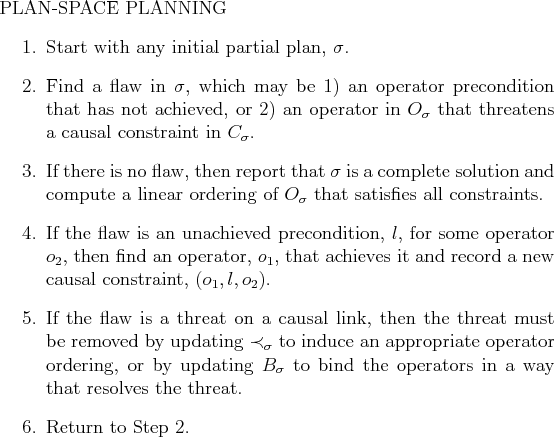
Next: 2.5.2 Building a Planning Up: 2.5 Logic-Based Planning Methods Previous: 2.5 Logic-Based Planning Methods
One alternative to searching directly in ![]() is to construct partial
plans without reference to particular states. By using the operator
representation, partial plans can be incrementally constructed. The
idea is to iteratively achieve required subgoals in a partial plan
while ensuring that no conflicts arise that could destroy the solution
developed so far.
is to construct partial
plans without reference to particular states. By using the operator
representation, partial plans can be incrementally constructed. The
idea is to iteratively achieve required subgoals in a partial plan
while ensuring that no conflicts arise that could destroy the solution
developed so far.
| (2.27) |
| (2.28) |
| (2.29) |
Several algorithms have been developed to search in the space of partial plans. To obtain some intuition about the partial-plan approach, a planning algorithm is described in Figure 2.19. A vertex in the partial-plan search graph is a partial plan, and an edge is constructed by extending one partial plan to obtain another partial plan that is closer to completion. Although the general template is simple, the algorithm performance depends critically on the choice of initial plan and the particular flaw that is resolved in each iteration. One straightforward generalization is to develop multiple partial plans and decide which one to refine in each iteration.
 |
In early works, methods based on partial plans seemed to offer substantial benefits; however, they are currently considered to be not ``competitive enough'' in comparison to methods that search the state space [382]. One problem is that it becomes more difficult to develop application-specific heuristics without explicit references to states. Also, the vertices in the partial-plan search graph are costly to maintain and manipulate in comparison to ordinary states.
Steven M LaValle 2020-08-14